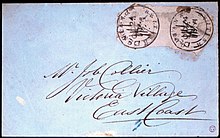Postage stamps and postal history of British Guiana


Provenance: Ferrary, King George V.

issued in 1860


A privately run packet service for mail existed in British Guiana in 1796, and continued for a number of years. Postage stamps of Britain were used in those days at Georgetown (Demerara) and Berbice. The first adhesive stamps produced by British Guiana were issued in 1850.
British Guiana is famous among philatelists for its early postage stamps, some of them considered to be among the rarest, most expensive stamps in the world. These include the unique British Guiana 1c magenta from 1856, which sold in 1980 for close to $1 million.
In June 2014 the 1856 British Guiana one-cent magenta stamp was sold at auction in New York, to an anonymous bidder, for $9.5m (£5.6m) at auction in New York, a world record.[1][2]
Independence
[edit]In 1966 the country achieved independence from the United Kingdom, and changed its name to Guyana. Later stamps were issued by Guyana.
See also
[edit]References and sources
[edit]- References
- ^ "Rare British Guiana stamp sets record at New York auction". BBC News. 17 June 2014.
- ^ "Our First Postage Stamps: The 'Cottonreels'", National Trust of Guyana Archived 2011-07-21 at the Wayback Machine
- Sources
- W.A. Townsend and F.G. Howe, Postage Stamps and Postal History of British Guiana, London, Royal Philatelic Society (August 1970) ISBN 0-900631-01-5
Further reading
[edit]- Proud, Ted. The Postal History of British Guiana. Proud-Bailey Co. Ltd., 2000. ISBN 1-872465-26-9
- L. N. Williams, "British Guiana's Cottonreels", Encyclopedia of Rare and Famous Stamps, v.I, pp.13-23. David Feldman (1992)
External links
[edit]- The British Guiana Study Circle.
- The British West Indies Study Circle.
- The British Caribbean Philatelic Study Group.
- Guyana Philatelic Society
